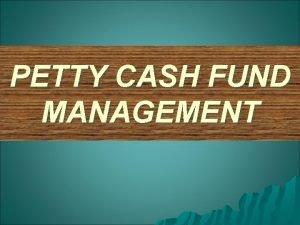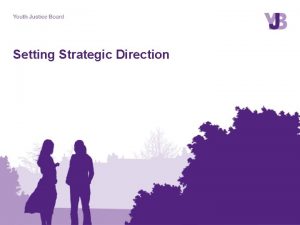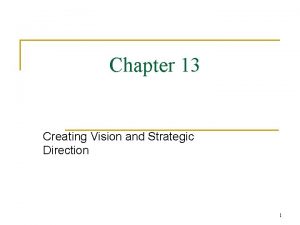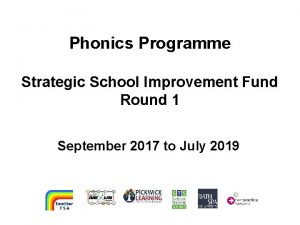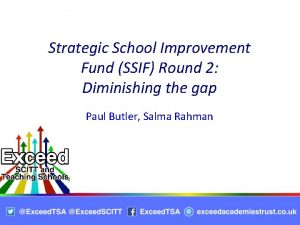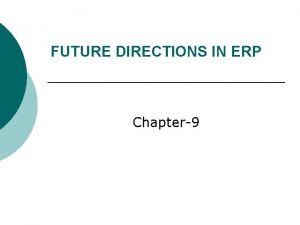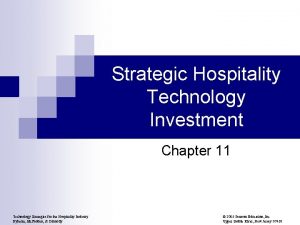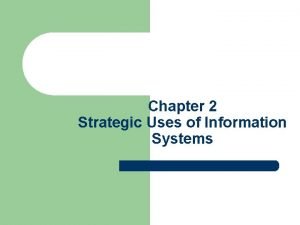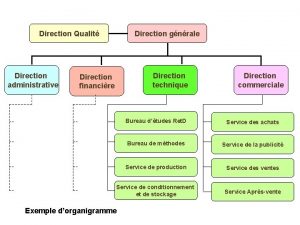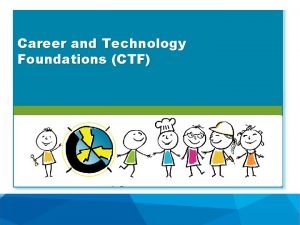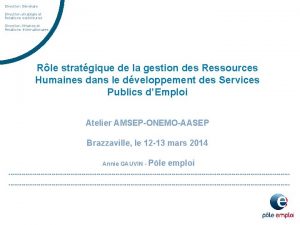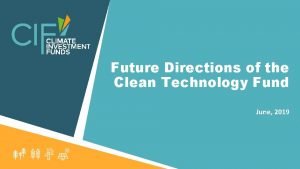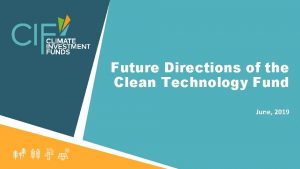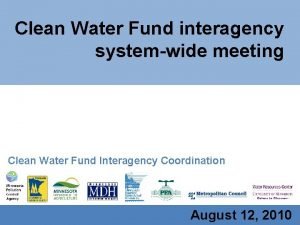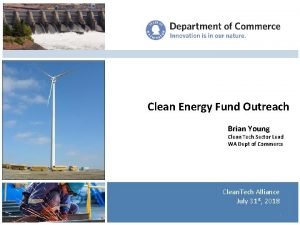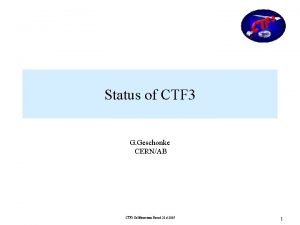Clean Technology Fund CTF Future Strategic Direction CTF















- Slides: 15

Clean Technology Fund (CTF) Future Strategic Direction

CTF on the ground. .

Story So Far 2008 CTF goes live! MDB partnership Innovation & flexibility Leveraging 2010 1 st CTF Disbursement Recorded 2013 Dedicated Private Sector Program created Private sector focus Deliver at scale & speed Flexibility 2013 MX Green Bond Securitization 2014 Contingent Recovery Grant Geothermal 2016 CTF Funds Fully Committed

Key features of the Business Model MDBs as implementing agencies AAA rated institutions with strong expertise in relevant climate-smart activities: • deal structuring • E&S • client engagement Operational Scale • • Large CTF envelope ($6. 1 bn) Substantial cofinancing ($53 bn) Toolkit of Instruments Suite of risk-appropriate tools: • equity • loans • mezzanine finance • guarantees • grants • local currency lending • advisory services Strong Governance & Flexible Business Model Flexible operational approach that can be adjusted according to the needs of both MDBs and the market

Numbers Disbursement Trend Funding 4000 100% 2500 2000 1500 1000 23% 30% 60% 45% 38% 40% 15% 20% 500 10. 0 0 8. 0 Renewable Energy 68% 2. 0 6. 0 3. 4 2. 0 0. 9 Government Bilateral/Others FY 15 FY 16 (1 st S) Disbursement rate (per MDB approval) MDB Target % GHG reductions (mt. CO 2 e/yr) 5. 5 44. 6 12% Co-financing ($m) 4, 028 33, 536 12% Installed capacity (MW) 1, 057 15, 039 7% 6 0% 8, 861 45% Additional passengers (m-PPD) Private sector Total leverage FY 14 Actual (RY 15) 8. 9 4. 0 3. 0 FY 13 Results 2. 5 5. 0 FY 12 Cumulative Disbursements 7. 0 1. 0 0% FY 11 9. 0 Energy Efficiency 15% 80% 3000 Energy savings (GWh/yr) 3, 952 *55 projects, or $3. 5 bn in MDB approved projects at various stages of implementation. Disbursement rate Sustainable Transport [PERCENTAG E] Leverage ratio Renewable Energy/Energy Efficiency 5% Funding (USD Million) 3500

Value proposition: CTF 2. 0 Opportunity • • • Emerging markets require an estimated $3 - 4 trillion annually in low-carbon investments over the next 15 years Country-level • Scarce public resources with MDBs uniquely positioned to help plug the gap with a broad range of offerings both in terms of sectors and instruments • MDB climate finance is expected to double by 2020 to $36 billion a year, with explicit demand for more concessional finance to help meet this goal CTF 2. 0 Barriers • • competing priorities Weak regulatory framework Lack of access to long-term, predictable, affordable finance Technology / commercial risks Project-level • High upfront costs • Low / no-revenue generation • Long time frames • High transaction costs • Lack of capacity • Lack of market knowledge • Limited access to capital markets, and narrow investor base Enhanced Programmatic Approach Building on experience e. g. countryprograms, DPSP Priority Investment Areas • Incl. energy storage, • Sustainable transport, • Energy efficiency in buildings, • Distributed generation New Financing Modalities • Green Markets • Risk Mitigation Facility

Potential investment priorities Energy Storage Opportunity • Manage intermittent and distributed nature of renewable energy • Improve grid efficiency • Cost effective alternative to aging transmission and distribution networks Barriers • Cost of technology and payback time • Lack of regulatory clarity • Uncertain revenue streams • Access to commercial finance Role of concessionality Facilitate scaling-up through interventions that help bridge gap to commercial project viability, mitigate risks, finance first-of-its-kind projects and support technical assistance work

Potential investment priorities Distributed generation Opportunity • Global capacity additions to surpass new centralized additions in 2018 • Over 80 GW of annual installed capacity in emerging markets (2014 -23) • Global distributed solar PV annual capacity additions to grow from 20 GW (2015) to over 30 GW (2020), $70 billion eq. market Barriers • Regulatory risks, due to lack of experience • Higher cost, compared to alternative fossil fuel choices • Lack of access to long-term financing • Complex stakeholder interests Role of concessionality • Lending for longer tenors than MDBs to improve project economics over fossil fuel based generation • Subordinated loans to demonstrate commercial viability • Early stage equity

Potential investment priorities Sustainable Transport Opportunity • Transport accounts for 23% of global CO 2 emissions addressing which would also result in co-benefits like reduced congestion, pollution and accidents, improved health, quality of life, enhanced productivity and economic growth Barriers • Revenue generating ability is often limited by affordability concerns; even operational cost recovery is a challenge, making it difficult to attract private sector funds at scale. CTF’s role • MDB-collective model critical to managing complex governance and risks involving environmental, social, inter-governmental, and public-private issues • Programmatic approach optimal for the types of transformative, systemic investments that will be required, whether with sub-national interventions or for private sector-led initiatives

Potential investment priorities Energy Efficiency in Buildings Opportunity • Account for about one-third of global energy use and related GHG emissions; with short payback periods, $1 invested in energy efficiency measures can potentially generate $3 in future fuel savings by 2050 Barriers • Higher costs • Lack of a market entity to absorb these costs • Lack of a system to validate savings; that hinders flow of capital to the sector • Lack of market information CTF’s role • Absorb incremental ‘greening’ cost, or provide performance assurances through innovative financial structures, or certification processes

CTF Green Markets Concept Move CTF to a self sustaining path through issuing investment grade, asset-backed securities in capital markets, drawing full value from the pool of diversified MDBoriginated legacy CTF assets to back the new securities Features Keep fundamentals such as MDB-collective model, range of instruments offered currently (e. g. loans, equity, guarantees etc. ) while supporting a wide range of sectors/ technologies, and attracting a broad investor base through a large diversified pool of green technology investments Achievable leverage Potentially raise USD 4. 25 billion (i. e. through a $500 - $750 million issuance every nine months), or USD 1. 5 billion in the absence of a contingent financing facility

Risk Mitigation Facility Concept Scale up mobilization of local and international private capital for clean technology projects through provision of risk mitigation guarantees (e. g. partial credit guarantee, first loss, second loss, contingent finance) by utilizing expected legacy CTF reflows Features • RMF guarantees (e. g. partial credit guarantee, first loss, second loss, contingent finance) would be issued on a non-accelerable basis • Established and operated by IBRD on behalf of the CTF; flexibly designed to include other participating CTF-MDBs to offer the products through an Umbrella Agreement Achievable leverage Initially USD 1 billion through ring fencing USD 1. 25 billion of legacy CTF reflows , with further expansion potentially funded through CTF Green Markets, on a standalone basis, by increasing the amount of ringfenced legacy CTF reflows

Next steps The CIF Administrative Unit, in consultation with the MDBs and Trustee to: • Adopt an enhanced programmatic approach • Explore and propose any modifications required in current CTF documents for implementation; • Focus on priority investment areas • Develop concrete proposals that could be implemented within 18 -24 months; • Develop new financing modalities • Conduct any necessary due diligence to fully develop proposals; • Identify legal implications • Explore any necessary modifications in CTF documents such as legal agreements and initiate any other necessary consultations with relevant parties; • Address Contributors’ interests • Conduct any necessary consultations on making available the reflows (and any other available assets in the CTF trust fund) for use in accordance with a decision by the Committee • Agree with the contributors on the required arrangements as soon as feasible.

Thank You! Mafalda Duarte Mduarte@worldbank. org (202) 473 - 4678 www. climateinvestmentfunds. org @CIF_Action https: //www. youtube. com/user/CIFaction https: //www. flickr. com/photos/cifaction/sets

Strategic highlights 3 X increase in climate financing to US$5 billion annually by 2020 >2 X increase in climate financing Up to US$6 billion by 2020 (US$4 billion/ mitigation, US$2 billion/ adaptation) Increase share of environment/climate financing from 25 to 40 % of annual commitments by 2020, reaching US$20 billion over the next 5 years Increase from 14 % of annual commitments to 25 -30 % by 2020 Total financing: $29 billion per year by 2020 Mobilize $25 billion of funds for clean energy over FY 16 – 20 (est. demand of non-IDA concessional finance of $3 -5 billion until 2020 in Energy sector only) FOCUS: (i) Renewable energy and energy efficiency (ii) Sustainable mobility (iii) Resilient, competitive low-carbon cities; (iv) Climate-smart land use and food security; (v) Green competitiveness; (vi) Leaving no one behind
 Future continuous vs future perfect exercises
Future continuous vs future perfect exercises Future simple continuous perfect
Future simple continuous perfect Clean up everybody let's clean up
Clean up everybody let's clean up Petty cash fund imprest and fluctuating
Petty cash fund imprest and fluctuating Setting strategic direction
Setting strategic direction Vision focuses on the current reality and maintaining it
Vision focuses on the current reality and maintaining it Strategic school improvement fund round 3
Strategic school improvement fund round 3 Strategic school improvement fund round 3
Strategic school improvement fund round 3 Strategic school improvement fund round 3
Strategic school improvement fund round 3 Future direction of erp
Future direction of erp Strategic fit vs strategic intent
Strategic fit vs strategic intent Strategic complements and substitutes examples
Strategic complements and substitutes examples Resource based model
Resource based model Analysing the 6 strategic options megxit
Analysing the 6 strategic options megxit Strategic hospitality technology investment
Strategic hospitality technology investment Vertical information systems
Vertical information systems



